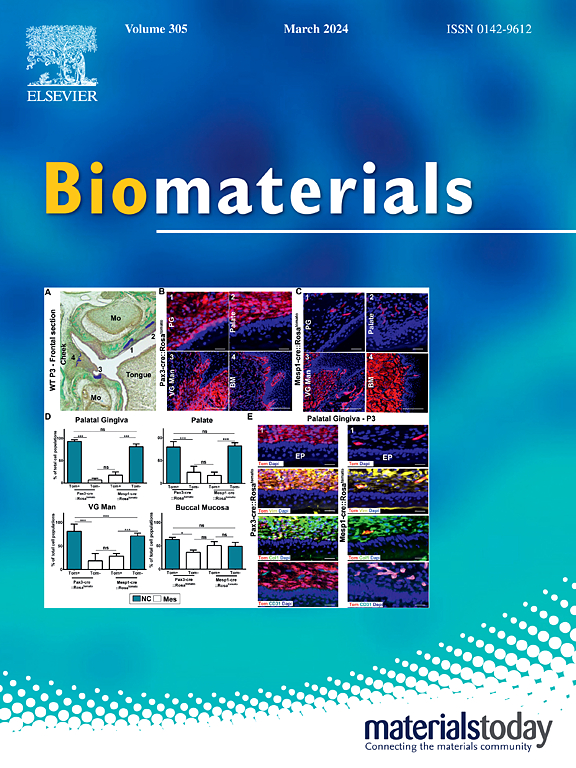Recent advances in exosome-based nanodelivery systems for Parkinson's disease
IF 12.8
1区 医学
Q1 ENGINEERING, BIOMEDICAL
引用次数: 0
Abstract
Parkinson's disease (PD) is a progressive neurodegenerative disorder that primarily affects dopaminergic neurons in the substantia nigra. Its multifactorial pathogenic mechanisms include oxidative stress, mitochondrial dysfunction, α-synuclein aggregation, neuroinflammation, and alterations in the gut microbiome, ultimately leading to neuronal deficits and debilitating motor and nonmotor symptoms. Although conventional therapies provide temporary relief, their efficacy tends to wane over time or produce adverse effects. Exosome-based therapeutic strategies are a promising alternative, and we highlight the unique advantages of exosomes, including their biocompatibility, low immunogenicity, and ability to cross the blood-brain barrier, thereby facilitating the targeted delivery of neuroprotective and anti-inflammatory medications to affected regions. We also discuss recent advances in exosome engineering to improve cargo loading, enhance cell specificity and improve efficacy. However, large-scale exosome production, targeted delivery and long-term safety remain major challenges. Early-phase clinical trials of exosome-based therapies in other neurodegenerative conditions have demonstrated acceptable tolerability, and ongoing preclinical studies in PD models suggest potential efficacy, laying the groundwork for future clinical translation.
基于外泌体的帕金森病纳米递送系统的最新进展
帕金森病(PD)是一种主要影响黑质多巴胺能神经元的进行性神经退行性疾病。其多因素致病机制包括氧化应激、线粒体功能障碍、α-突触核蛋白聚集、神经炎症和肠道微生物群改变,最终导致神经元缺陷和衰弱的运动和非运动症状。虽然传统疗法提供暂时的缓解,但其功效往往随着时间的推移而减弱或产生不良反应。基于外泌体的治疗策略是一个很有前途的选择,我们强调了外泌体的独特优势,包括它们的生物相容性、低免疫原性和穿越血脑屏障的能力,从而促进了神经保护和抗炎药物靶向递送到受影响的区域。我们还讨论了外泌体工程在改善载货量、增强细胞特异性和提高功效方面的最新进展。然而,大规模外泌体的生产、靶向递送和长期安全性仍然是主要挑战。基于外泌体的治疗方法在其他神经退行性疾病的早期临床试验已经证明了可接受的耐受性,并且正在进行的PD模型临床前研究显示了潜在的疗效,为未来的临床转化奠定了基础。
本文章由计算机程序翻译,如有差异,请以英文原文为准。
求助全文
约1分钟内获得全文
求助全文
来源期刊

Biomaterials
工程技术-材料科学:生物材料
CiteScore
26.00
自引率
2.90%
发文量
565
审稿时长
46 days
期刊介绍:
Biomaterials is an international journal covering the science and clinical application of biomaterials. A biomaterial is now defined as a substance that has been engineered to take a form which, alone or as part of a complex system, is used to direct, by control of interactions with components of living systems, the course of any therapeutic or diagnostic procedure. It is the aim of the journal to provide a peer-reviewed forum for the publication of original papers and authoritative review and opinion papers dealing with the most important issues facing the use of biomaterials in clinical practice. The scope of the journal covers the wide range of physical, biological and chemical sciences that underpin the design of biomaterials and the clinical disciplines in which they are used. These sciences include polymer synthesis and characterization, drug and gene vector design, the biology of the host response, immunology and toxicology and self assembly at the nanoscale. Clinical applications include the therapies of medical technology and regenerative medicine in all clinical disciplines, and diagnostic systems that reply on innovative contrast and sensing agents. The journal is relevant to areas such as cancer diagnosis and therapy, implantable devices, drug delivery systems, gene vectors, bionanotechnology and tissue engineering.
 求助内容:
求助内容: 应助结果提醒方式:
应助结果提醒方式:


